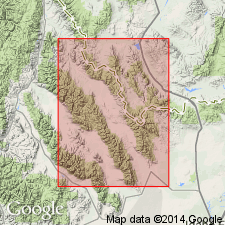
- Usage in publication:
-
- Middle Canyon Formation
- Modifications:
-
- Named
- Dominant lithology:
-
- Siltstone
- Limestone
- AAPG geologic province:
-
- Snake River basin
Summary:
Named as basal (of four) formation of White Knob Group (rank raised) for exposures near mouth of Middle Canyon (its type section), southern Lemhi Range, Butte Co, ID, Snake River basin. Overlies Milligen Formation gradationally; contact is dark-gray shale or mudstone (Milligen) under brown siltstone (Middle Canyon). Consists of 1,100 ft (at type) of yellowish-brown, calcareous quartz siltstone and sandstone with no chert, and thin-bedded, dark-gray fine-grained limestone with 10-50 percent black chert. The siltstone has quartz, calcite or dolomite grains, minor amounts of tourmaline, zircon, plagioclase, and muscovite, and the grains vary in size from coarse silt to fine sand. Few fossils found in siltstone. Siltstone content becomes less significant away from type. The limestones contain predominantly angular, coarse silt to fine sand bioclastic (crinoid and bryozoan parts) debris. Coral fossils identified. Upper contact with Scott Peak Formation (new) of White Knob Group is placed at base of first coarse, light-gray crinoidal calcarenite bed. Columnar section. Is a slope- and ledge-former. Name used in miogeosyncline to east margin of transition zone. East of that area, term Madison Group used. Mississippian age. Columnar section.
Source: GNU records (USGS DDS-6; Denver GNULEX).
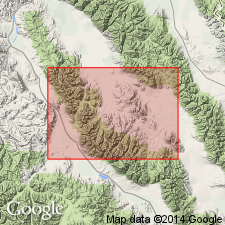
- Usage in publication:
-
- Middle Canyon Formation*
- Modifications:
-
- Biostratigraphic dating
- Age modified
- Reference
- Dominant lithology:
-
- Siltstone
- Limestone
- AAPG geologic province:
-
- Snake River basin
Summary:
Reference section about 780 ft thick designated along crest of ridge in N1/2 SW1/4 sec 24, T9N, R26E, Butte Co, ID in the Snake River basin. Shown at reference as a calcareous sandstone. In the Lost River Range, the formation consists of poorly exposed, reddish-brown-weathering, calcareous, thin- to medium-bedded siltstone and silty limestone, and a few interbedded thick bioclastic limestone lenses. Chert in pods and lenses abundant in some beds. Is 600 ft thick in Doublespring quad and nearly 700 ft thick in Hawley Mountain quad. Forams and other microfossils indicate deposition in very shallow water. The fauna is no older than Foraminifera Zone 13, or of middle Meramecian, late middle Visean age. Fossils listed (forams). Brachiopods and corals found in lower part of formation. Correlation chart; cross section. Correlated with lower part of Little Flat Formation of Chesterfield Range Group of southeast ID. Is the oldest unit discussed in report; basal part of formation not discussed. Underlies Scott Peak Formation. [Term White Knob Group (Huh, 1967) not used.] Assigned to megafossil zones pre-E, E?, and E.
Source: GNU records (USGS DDS-6; Denver GNULEX).
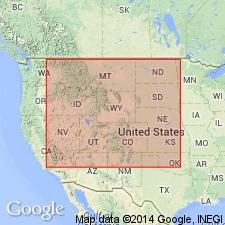
- Usage in publication:
-
- Middle Canyon Formation*
- Modifications:
-
- Age modified
- AAPG geologic province:
-
- Snake River basin
Summary:
Previously considered entirely Late Mississippian age. A middle Osagean conodont fauna identified in lower part at Long Canyon, Beaverhead Mountains, ID in Clark Co in Snake River basin. Age changed to Early and Late Mississippian.
Source: GNU records (USGS DDS-6; Denver GNULEX).
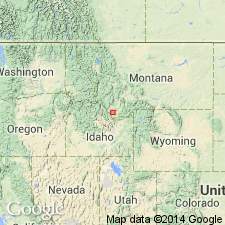
- Usage in publication:
-
- Middle Canyon Formation*
- Modifications:
-
- Revised
- Areal extent
- AAPG geologic province:
-
- Montana folded belt
Summary:
Extended from south-central ID into Beaverhead Co, MT in the Montana folded belt province and placed in Tendoy Group (new name). Is the second formation (of four) from base, assigned to Tendoy. Overlies Paine Limestone (revised in rank) of Tendoy; underlies Mission Canyon Limestone (reassigned from Madison Group) of Tendoy. Is a deep-water foreslope deposit. Consists of three informal members in the northern Tendoy Mountains, where it is entirely of Osagean, or Early Mississippian age (corals, conodonts, brachiopods). Stratigraphic chart. Composite section. Geologic map.
Source: GNU records (USGS DDS-6; Denver GNULEX).
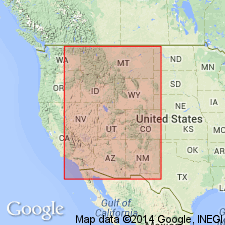
- Usage in publication:
-
- Middle Canyon Formation*
- Modifications:
-
- Age modified
- Biostratigraphic dating
- AAPG geologic province:
-
- Snake River basin
Summary:
Ammonoid ROTOPERICYCLUS (ROTOPERICYCLUS) SINYONENSIS n. sp. collected on south slope of Beaverhead Mountains, Clark Co, ID in the Snake River basin. Associated conodonts indicate late Kinderhookian age and place it in the SIPHONODELLA ISOSTICHA--Upper S. CRENULATA Zone.
Source: GNU records (USGS DDS-6; Denver GNULEX).
For more information, please contact Nancy Stamm, Geologic Names Committee Secretary.
Asterisk (*) indicates published by U.S. Geological Survey authors.
"No current usage" (†) implies that a name has been abandoned or has fallen into disuse. Former usage and, if known, replacement name given in parentheses ( ).
Slash (/) indicates name conflicts with nomenclatural guidelines (CSN, 1933; ACSN, 1961, 1970; NACSN, 1983, 2005, 2021). May be explained within brackets ([ ]).

